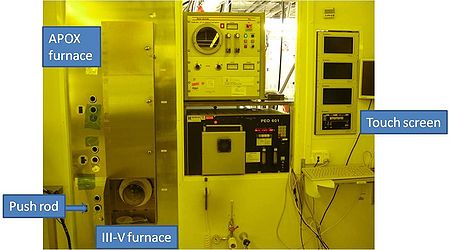Specific Process Knowledge/Thermal Process/D4 III-V Oven: Difference between revisions
Created page with "'''Feedback to this page''': '''[mailto:labadviser@danchip.dtu.dk?Subject=Feed%20back%20from%20page%20http://labadviser.danchip.dtu.dk/index.php?title=Specific_Process_Knowled..." |
|||
| (13 intermediate revisions by 5 users not shown) | |||
| Line 1: | Line 1: | ||
'''Feedback to this page''': '''[mailto:labadviser@danchip.dtu.dk?Subject=Feed%20back%20from%20page%20http://labadviser.danchip.dtu.dk/index.php?title=Specific_Process_Knowledge/ | {{cc-nanolab}} | ||
'''Feedback to this page''': '''[mailto:labadviser@danchip.dtu.dk?Subject=Feed%20back%20from%20page%20http://labadviser.danchip.dtu.dk/index.php?title=Specific_Process_Knowledge/Thermal_Process/D4_III-V_Oven click here]''' | |||
<br> | |||
===<span style="color:Red">The D4 III-V Oven has been decomission in August 2019.</span>=== | |||
<br> | |||
[[Category: Equipment |Thermal III-V ]] | |||
[[Category: Thermal process|III-V]] | |||
[[Category: Furnaces|III-V]] | |||
==III-V Oven (D4)== | ==III-V Oven (D4)== | ||
[[Image:IIIV_Oven.jpg|thumb|450x450px|III-V Oven (D4). Positioned in cleanroom area F-3.]] | [[Image:IIIV_Oven.jpg|thumb|450x450px|III-V Oven (D4). Positioned in cleanroom area F-3/ Photo: DTU Nanolab internal.]] | ||
The III-V Oven (D4) is used for wet thermal oxidation of III-V devices, for instance for lateral oxidation of thin AlGaAs layers to defined apertures in light-limiting diodes. | The III-V Oven (D4) is used for wet thermal oxidation of III-V devices, for instance for lateral oxidation of thin AlGaAs layers to defined apertures in light-limiting diodes. | ||
The furnace is an old Tempress horizontal furnace. The quartz boat is loaded manually into the furnace by use of a push rod. The furnace is cooled down to room temperature when it is not being used. | The furnace is an old Tempress horizontal furnace. The quartz boat is loaded manually into the furnace by use of a push rod. The furnace is cooled down to room temperature when it is not being used. | ||
Before use, devices have to be cleaned. A short BHF dip can be used to remove any native oxide which can be difficult to penetrate by a wet thermal oxidation. | Before use, devices have to be cleaned. A short BHF dip can be used to remove any native oxide which can be difficult to penetrate by a wet thermal oxidation. | ||
| Line 15: | Line 24: | ||
'''[http://www.labmanager.danchip.dtu.dk/function.php?module=Machine&view=view&mach=187 III-V Oven (D4)]''' | '''[http://www.labmanager.danchip.dtu.dk/function.php?module=Machine&view=view&mach=187 III-V Oven (D4)]''' | ||
==Overview of the performance of the III-V Oven and some process related parameters== | ==Overview of the performance of the III-V Oven and some process related parameters== | ||
Latest revision as of 15:18, 3 June 2025
The content on this page, including all images and pictures, was created by DTU Nanolab staff, unless otherwise stated.
Feedback to this page: click here
The D4 III-V Oven has been decomission in August 2019.
III-V Oven (D4)

The III-V Oven (D4) is used for wet thermal oxidation of III-V devices, for instance for lateral oxidation of thin AlGaAs layers to defined apertures in light-limiting diodes.
The furnace is an old Tempress horizontal furnace. The quartz boat is loaded manually into the furnace by use of a push rod. The furnace is cooled down to room temperature when it is not being used.
Before use, devices have to be cleaned. A short BHF dip can be used to remove any native oxide which can be difficult to penetrate by a wet thermal oxidation.
Please check the cross contamination information in LabManager before you use the furnace.
The user manual and contact information can be found in LabManager:
| Purpose |
| |
|---|---|---|
| Performance | Lateral oxidation rate |
|
| Process parameter range | Process temperature |
|
| Process pressure |
| |
| Gasses on the system |
| |
| Substrates | Batch size |
|
| Substrate materials allowed |
|
